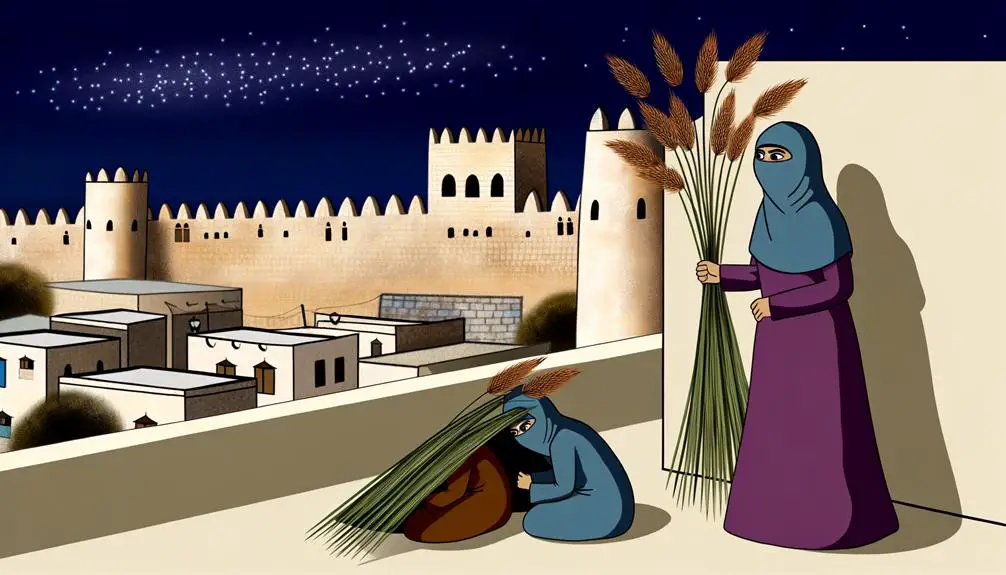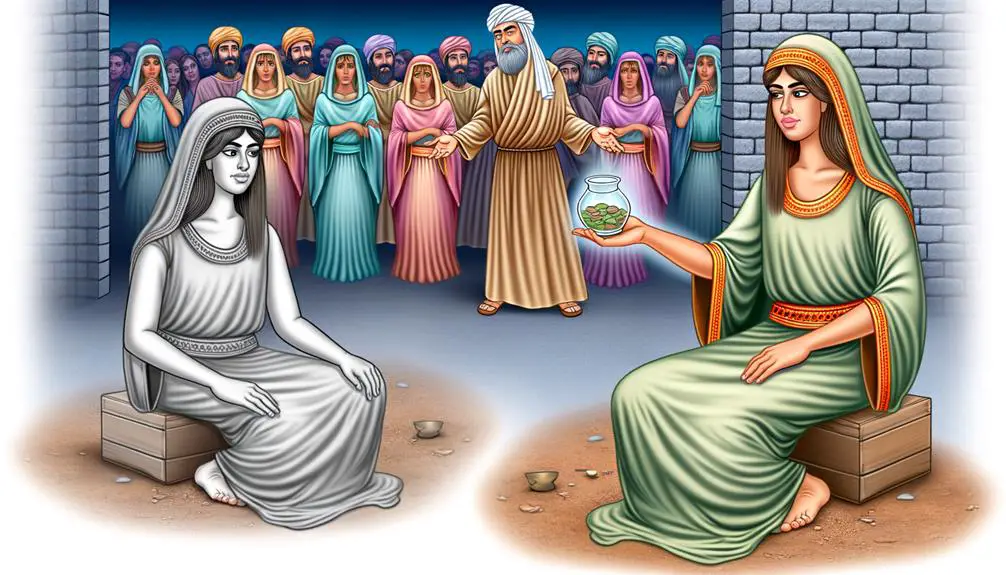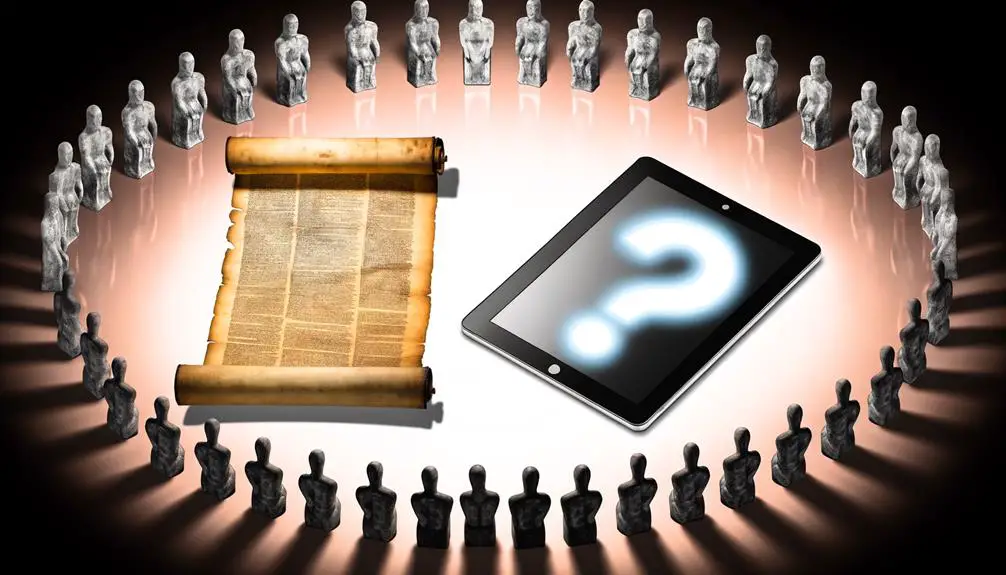Navigate the complex moral landscapes of biblical stories on prostitution, revealing timeless lessons on forgiveness, judgment, and redemption.

Prostitution in the Bible Verses
In the tapestry of biblical narratives, the threads of prostitution are woven with both caution and complexity. You'll find that these stories aren't merely historical accounts, but rather, they serve as a mirror, reflecting the moral and ethical dilemmas faced by society throughout the ages.
From Rahab's scarlet cord to the enigmatic figure of Mary Magdalene, the subject of prostitution in the Bible opens a window into the nuanced understanding of morality, repentance, and redemption. As we explore these passages, you'll be invited to question and perhaps redefine your perspectives on forgiveness, judgment, and the capacity for change within every individual.
Why do these stories matter today, and how do they influence our modern views on morality and sin?
Key Takeaways
- Biblical narratives often use prostitution to convey socio-economic struggles and moral lessons.
- Figures like Rahab illustrate redemption and the transformative power of faith despite past transgressions.
- Early Christian texts, particularly by Paul, underscore the incompatibility of sexual immorality with a devout life.
- Modern discussions on prostitution and ethics can still draw on ancient texts for insights and guidance.
Historical Context of Prostitution

Throughout history, prostitution has been a complex socio-economic phenomenon, deeply intertwined with the cultural, economic, and legal frameworks of societies. In ancient economies, where survival often depended on the interplay between social status and economic activity, prostitution emerged not merely as a profession but as a nuanced institution reflecting and shaping societal norms and values. You'll find that in these contexts, the role and perception of prostitution were significantly influenced by the prevailing social status hierarchies.
In analyzing the historical context of prostitution, it's imperative to recognize the economic imperatives that drove individuals towards this profession. In ancient societies, where economic opportunities for women were severely limited, prostitution provided a viable means of livelihood for many. This economic dimension, however, can't be viewed in isolation. The social status of individuals engaged in prostitution was intricately linked to the broader societal attitudes towards gender, sexuality, and morality.
You'll observe that in some ancient cultures, prostitutes occupied a dual role, embodying both marginalization and reverence within society. Their social status was paradoxical, reflecting deep-seated ambivalences about sexuality and purity. In these societies, prostitution wasn't merely an economic activity but also a lens through which the complexities of social stratification and gender dynamics could be examined.
It's crucial to approach the historical context of prostitution with a nuanced understanding of how ancient economies and social status frameworks influenced its evolution. By doing so, you gain insights into the multifaceted ways in which prostitution has been perceived, regulated, and integrated into societies throughout history.
Rahab: A Harlot's Tale

You'll find Rahab's narrative intriguing as it intertwines with the broader themes of redemption and transformation within the biblical context.
Her role in Jericho, not merely as a harlot but as a pivotal figure in the Israelite spies' survival, prompts a deeper analysis of her actions and their implications.
Examining Rahab's faith and its subsequent reward sheds light on her enduring legacy, challenging traditional views on morality and divine grace.
Rahab's Identity Unveiled
Rahab's story, often simplified to that of a harlot, reveals a complex identity entwined with themes of faith, redemption, and survival in the biblical narrative. Delving into her lineage, one discovers a woman whose actions—rooted in espionage tactics—not only alter her own fate but also significantly influence the course of Israelite history.
Jericho: Rahab's Intervention
In the ancient city of Jericho, a pivotal intervention by Rahab, often labeled as a harlot, showcases her critical role in the Israelite's strategic victory. Her actions, embedded in a narrative of survival and espionage, underscore the complexity of Jericho's strategy and the spies' courage.
You'll find her decision to shelter the Israelite spies not just a mere act of defiance against her city but as a calculated move that profoundly influenced the course of the conflict. Analyzing Rahab's intervention reveals her acute awareness of the geopolitical shifts at play and her ability to navigate them to her advantage.
Her engagement with the spies demonstrates a blend of courage and strategic insight, marking a turning point in the siege of Jericho.
Faith's Reward and Legacy
Moving beyond Rahab's strategic intervention, we explore the profound impact of her faith on her legacy and the rewards it garnered within the biblical narrative. Rahab's story transcends her initial economic necessity and social stigma, illustrating a dramatic shift from marginalization to honor in the annals of faith history.
Aspect |
Impact |
|---|---|
Faith |
Transcendence |
Legacy |
Honor |
Economic Necessity |
Transformation |
Social Stigma |
Reversal |
Biblical Narrative |
Inclusion |
Her tale, deeply embedded in the text, serves as a testament to the power of faith over circumstance. Rahab's journey from a harlot to a heralded ancestor in the lineage of Christ underscores a critical biblical narrative: redemption and inclusion are accessible, transcending economic and social confines.
Prophetic Warnings and Metaphors

Throughout biblical texts, prophets frequently employ the metaphor of prostitution to issue stark warnings against infidelity and moral decay among the people. This imagery isn't merely for shock value; it serves as a powerful tool in conveying divine disapproval and urging a return to faithfulness. By understanding the context and implications of these metaphors, you can gain deeper insights into the biblical perspective on morality and societal health.
The use of prostitution as a metaphor is deeply rooted in divine allegories and societal parallels, illustrating the severity of turning away from divine teachings:
- Divine Allegories: The prophets often use the metaphor of prostitution to depict Israel's relationship with God. This allegory portrays the nation's infidelity through idolatry and forsaking the covenant with God as akin to the betrayal in a marriage.
- Societal Parallels: These metaphors draw a parallel between the moral decay within a society and the act of prostitution. The prophets warn that just as prostitution represents a departure from the sanctity of marriage, societal immorality signifies a departure from divine laws.
- Call to Repentance: Through these stark images, prophets not only condemn but also call for repentance, emphasizing the possibility of forgiveness and restoration if the people return to a path of righteousness.
- Consequences of Disobedience: The metaphors serve as a warning about the consequences of continued disobedience, depicting the devastation that moral decay can bring upon a nation.
Sexual Immorality in New Testament

In the New Testament, you'll find that early Christian definitions of sexual immorality expand upon Old Testament principles, reflecting a broader societal context. Paul's warnings and teachings on this matter are pivotal, emphasizing the community's responsibility to uphold moral standards.
Lastly, the texts offer paths for repentance and redemption, showcasing a shift towards personal transformation and community support.
Definitions in Early Christianity
Early Christian texts, particularly in the New Testament, address sexual immorality, offering definitions that have influenced Christian ethics and teachings. These definitions have shaped early interpretations of Christian morality, emphasizing purity and fidelity.
- Fornication: Often seen as sexual relations outside of marriage, this was broadly condemned.
- Adultery: Defined as sexual relations where at least one party is married to someone else, it's strictly prohibited.
- Prostitution: Viewed negatively, it's often associated with idolatry and moral decay.
- Purity: Not just physical, but a state of moral and spiritual cleanliness.
These concepts played a crucial role in the formation of early Christian ethical views, setting a foundation for discussions on sexual behavior within the faith community.
Paul's Warnings and Teachings
Paul's epistles to the early Christian communities contain stern warnings about the dangers of sexual immorality, emphasizing its incompatibility with a life dedicated to Christ. His apostolic advice navigates the fine line between cultural norms of the time and the ethical standards expected of followers of Jesus. Paul's writings offer a clear, unambiguous stance against sexual immorality, marking it as a behavior that not only contravenes spiritual purity but also the communal integrity of the early church.
Epistle |
Key Theme |
Implication |
|---|---|---|
1 Corinthians |
Immorality in the Church |
Calls for purity |
Galatians |
Works of the Flesh |
Lists sexual immorality as a major sin |
Ephesians |
New Life in Christ |
Encourages a break from past behaviors |
Through these letters, Paul sets a foundational moral compass for Christians, intertwining spiritual devotion with ethical living.
Repentance and Redemption Paths
Building on Paul's admonitions against sexual immorality, the New Testament further explores pathways of repentance and redemption for those seeking to realign with Christian ethical standards. This exploration reveals a nuanced understanding of grace dynamics and forgiveness pathways, offering hope and transformation for individuals entangled in practices of sexual immorality.
- Confession: Acknowledging one's transgressions is a pivotal first step toward healing and restoration.
- Repentance: A genuine change of heart and mind, steering away from past behaviors.
- Seeking Forgiveness: Directly appealing to God for pardon, leveraging the forgiveness pathways outlined in the New Testament.
- Embracing Grace: Understanding and accepting the grace dynamics that enable a fresh start, regardless of past missteps.
This analytical approach underscores the New Testament's comprehensive framework for overcoming sexual immorality through repentance and redemption.
The Case of Mary Magdalene

Mary Magdalene's story, often misconstrued, serves as a complex example of how biblical narratives have been interpreted regarding prostitution. The Gospel narratives introduce her as a prominent follower of Jesus, with her identity and life story sparking various Magdalene misconceptions over the centuries. Contrary to popular belief, there's no explicit biblical text that identifies her as a prostitute. This misconception likely stems from the conflation of her story with other women mentioned in the Gospels, notably the unnamed sinner in Luke 7:36-50, who anoints Jesus' feet.
Analyzing the texts, it's clear that Mary Magdalene's portrayal in the Bible is quite different from the prostitute label she's been wrongfully given. The Gospels of Matthew, Mark, Luke, and John consistently describe her as a devoted follower of Jesus, present at his crucifixion, and the first to witness his resurrection. Notably, Luke 8:2-3 mentions her as one of the women who were cured of evil spirits and infirmities, stating specifically that 'seven demons had gone out' of her. This description is a far cry from an identification as a prostitute.
The leap to label Mary Magdalene as such without textual support illustrates a broader issue of interpretation and the potential for significant misconceptions based on cultural, historical, and theological biases. It's essential to approach Gospel narratives with a critical eye, recognizing the layers of interpretation and tradition that have shaped our understanding of these figures.
Moral Lessons and Interpretations

Examining biblical narratives, especially those involving figures like Mary Magdalene, reveals crucial moral lessons and interpretations that challenge and enrich our understanding of virtue and redemption. These stories, while ancient, continue to confront us with ethical dilemmas that resonate with contemporary implications.
In the exploration of these narratives, you'll uncover that:
- The tales often highlight the complexity of human nature, reminding us that people are capable of both sin and profound transformation.
- They encourage a stance of compassion and understanding towards those who are marginalized or judged by society, urging us to look beyond surface appearances.
- The stories serve as a call to recognize the potential for redemption and change, not just in biblical times but in today's world as well.
- Finally, these narratives challenge us to confront our own prejudices and to consider the broader implications of our actions and judgments on individuals and society at large.
Such insights are invaluable as they push you to navigate the ethical dilemmas presented in the text and apply these lessons to modern-day scenarios. The contemporary implications of these biblical stories are profound, offering guidance on how to approach issues of morality, justice, and redemption in a complex world. By engaging with these narratives, you're invited to reflect on your own values and the societal norms that shape our understanding of right and wrong. This exploration not only enhances your grasp of biblical ethics but also enriches your capacity to address the moral challenges of the present day.
Prostitution in Wisdom Literature

Turning our focus to the Wisdom Literature, we find prostitution discussed in a context that offers unique insights into moral and ethical considerations. This corpus, including books traditionally attributed to Solomon and others like Job, addresses complex human behaviors and societal issues with a depth that invites reflection.
Solomon's paradox, a term derived from the apparent contradiction in Solomon's own life—his wisdom juxtaposed with his moral failures, including relationships with foreign women who were possibly prostitutes or concubines—sheds light on the nuanced treatment of prostitution in Wisdom Literature. Solomon's writings, particularly in Proverbs, caution against the allure of the 'strange woman,' often interpreted as a metaphor for folly and moral decay. This cautionary stance isn't merely a moralistic warning but a profound exploration of the consequences of unwise choices, framed within the context of seeking wisdom and understanding.
Conversely, Job's silence on the matter of prostitution is equally telling. The Book of Job, dealing with questions of suffering, justice, and righteousness, doesn't explicitly address prostitution. This omission might reflect the book's focus on existential and theological questions, suggesting that the issue of prostitution, while relevant, doesn't directly pertain to Job's discourse on human suffering and divine justice.
Together, these perspectives from Wisdom Literature contribute to a broader understanding of prostitution within biblical texts. They challenge readers to consider not just the act of prostitution but also the underlying moral, ethical, and societal complexities. This scholarly approach encourages a thoughtful examination of how wisdom and folly, righteousness and sin, are intertwined in the human experience.
Modern Perspectives and Debates

How do modern scholars interpret the biblical narratives on prostitution, and what debates arise from these interpretations? You're stepping into a complex arena where historical context, theological perspectives, and contemporary ethics collide. The discussion isn't just academic; it carries significant legal implications and societal impacts, shaping how communities view morality, legality, and social justice today.
- Historical Contextualization: Scholars often start by placing biblical narratives in their historical and cultural context. This approach helps you understand the economic and social factors that contributed to prostitution in ancient times. The debate here revolves around whether these contexts justify, condemn, or simply explain the practice.
- Theological Interpretations: Theological perspectives diverge significantly. Some view these narratives as outright condemnations of prostitution, while others see them as complex texts that reflect the nuanced views of different biblical authors. This leads to debates on the moral lessons that should be drawn today.
- Legal Implications: How biblical narratives on prostitution influence modern law is a hot topic. You'll find scholars debating whether these texts should have any bearing on the legality of prostitution or if they contribute to policies that either protect or harm sex workers.
- Societal Impacts: Finally, there's a broad discussion on how these interpretations affect societal attitudes towards sex work and those involved in it. This includes how stigma, support systems, and social justice initiatives are influenced by religious beliefs.
As you delve into these modern perspectives and debates, you're confronted with an intricate tapestry where ancient texts meet contemporary issues, challenging you to consider how ancient wisdom informs modern ethics and law.
Frequently Asked Questions
How Do Various Christian Denominations Today Reconcile or Address the Biblical References to Prostitution in Their Teachings and Pastoral Care?
In addressing how Christian denominations today approach references to prostitution in their teachings and pastoral care, you'll find a range of church policies and pastoral challenges. Different churches interpret these references uniquely, often reflecting broader theological stances.
Some emphasize redemption and transformation, focusing on pastoral care that aims to support and rehabilitate. Others might lean towards a more doctrinal approach, highlighting moral teachings and community standards.
What Are the Psychological and Societal Implications of the Portrayal of Prostitution in the Bible on Contemporary Views and Treatment of Sex Workers?
The portrayal of prostitution influences contemporary views and treatment of sex workers, affecting legal reforms and mental health.
You'll find that societal stigma can hinder the push for legal protections, while also impacting the mental health of those within the profession.
Analyzing this dynamic offers insight into the need for more humane policies and a shift in societal perception, emphasizing the importance of understanding and compassion in addressing these issues.
Are There Any Archaeological Findings or Historical Evidence Outside of Biblical Texts That Support or Contradict the Biblical Narratives Involving Prostitution?
You're diving into whether archaeological findings or historical evidence back up or refute narratives around prostitution, beyond biblical texts.
It's crucial to explore how ancient economies and social stigmatization intersected with this profession. Through an analytical lens, you'll find that evidence varies, suggesting that while some findings align with biblical portrayals, others challenge or provide a nuanced view, reflecting the complexity of sex work in ancient societies.
How Do Feminist Theologians Interpret the Stories of Women Involved in Prostitution in the Bible, and What Implications Does This Have for Gender Roles and Equality in Modern Religious Practice?
You're diving into how feminist theologians interpret biblical stories of women in prostitution, focusing on sacred feminism and interpretive methodologies. They often see these narratives as windows into gender roles and equality, challenging traditional interpretations.
Through these lenses, they advocate for a reevaluation of gender dynamics in modern religious practices, pushing for greater inclusivity and equality. This approach has significant implications for understanding and reshaping contemporary gender roles within religious contexts.
In What Ways Have Artists, Musicians, and Writers Been Inspired by the Biblical Accounts of Prostitution to Create Works That Reflect or Comment on These Themes in Contemporary Culture?
Artists, musicians, and writers have long turned over a new leaf, drawing inspiration from challenging themes to create impactful works.
You'll find that literary motifs and music genres alike are enriched by their reflections on these narratives, shedding light on contemporary issues.
This approach not only bridges the gap between ancient texts and modern discourse but also offers a nuanced exploration of human experiences, urging a deeper understanding and dialogue within society.
Conclusion
In weaving through the tapestry of biblical narratives and teachings, you've explored the multifaceted portrayals of prostitution, from Rahab's redemption to the cautionary tales of sexual immorality.
Like a mirror reflecting society's complex views on morality and redemption, these stories offer profound insights into human nature and divine grace.
As you reflect on the juxtaposition of historical context and modern debates, it's clear that the conversation around prostitution in the Bible is as rich and nuanced as the text itself.



Sign up